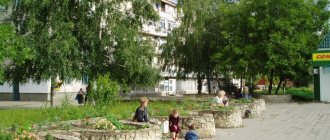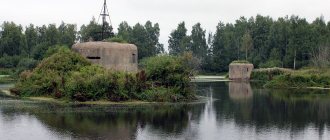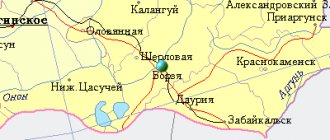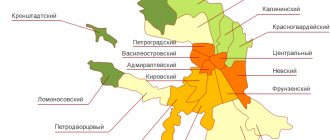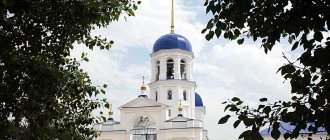Lyuban
, a city in Russia, part of the Tosnensky district of the Leningrad region, the administrative center of the Lyubansky urban settlement, within the Tosnensky deanery of the Gatchina diocese. Located at the southern foot of the Baltic-Ladoga ledge, on the Tigoda River, a tributary of the Volkhov River, 85 km southeast of St. Petersburg. Railway station on the St. Petersburg-Moscow line. Population - 4.6 thousand people. (2018)
- On the map: Yandex.Map, Google map
It was first mentioned in Novgorod scribe books in 1500 as the trading settlement of Lyuban. The name is derived from the common toponymic basis of any
using the suffix
-an
.
On January 2, 1711, a postal route was established between St. Petersburg and Moscow, passing through Lyuban. One of the chapters of Alexander Nikolaevich Radishchev’s book “Journey from St. Petersburg to Moscow” is dedicated to Lyuban.
In the spring of 1843, construction of a railway line began between St. Petersburg and Moscow, in 1849 the first passenger train passed through Lyuban, and in 1850 a railway station building was built.
In 1867, next to the station, the Peter and Paul Church was built according to the design of the architect K. A. Ton, which is the only temple of railway workers in Russia. In 1868 the first railway school was built.
From the middle of the 19th century, Lyuban became the volost center of the Novgorod district of the Novgorod province, and one of the popular summer cottages for residents of St. Petersburg.
In 1912, Lyuban received city status.
From 1917 to 1927 - the administrative center of the Lyuban volost of the Novgorod district of the Novgorod province.
From 1927 to 1930 - the administrative center of the Lyubansky district of the Leningrad region.
In 1930 it became part of the Tosnensky district of the Leningrad region.
On August 25, 1941, during the Great Patriotic War, it was occupied by Nazi troops. Liberated on January 28, 1944 by troops of the Volkhov Front during the Novgorod-Luga operation.
Since February 1, 1963, the city has been subordinate to the Tosno City Council.
On January 1, 2006, the municipal entity “Lyuban urban settlement” was formed, and Lyuban became its administrative center.
Denis Blishch. Private opinion
▶︎ A fun Instagram about the nooks and crannies of Minsk, Belarus and the whole world!
◀︎ In 2004, I graduated from the journalism department of BSU and, like all state employees, went through the distribution procedure. I was prepared for the procedure: I had a letter of guarantee from BelTA in my pocket, and my work book had been kept in this very agency for a long time. But some of my classmates did not care about the “guarantee” and received a start in life from the backyard: this is how Sasha Ivanov got the prospect of working as an editor at the Lyubansky regional radio for two years. He honestly rattled off his deadline from bell to bell, and over these two years I went to see him a couple of times on business trips - we drank vodka in his dorm room, the next day he ran to the radio, I went to the villages to get material. This is how I became acquainted with the city of Lyuban, but happily forgot about it when Sasha returned to Minsk. Damn it, this is one of the most nondescript Belarusian cities! It’s hard to think of why one would go here without a specific purpose: there is so much nothing here that the most beautiful building is a white brick high-rise on the outskirts. My local history duty was to walk the streets of the regional center. I passed.
Lyuban did not have a railway, so the main window to the world is the bus station. Buses from Minsk and Soligorsk arrive here, and there are also several passing through. In principle, communication with the outside world is not very good, which is explained by the presence of a nearby mining town with a population of one hundred thousand. All attention to him, all the passenger flows are there.
Near the station, the “Tabakerki” kiosk rots forlornly. Everywhere I've seen them they remain inoperative. The only exception is Zhabinka, but the “Tabakerka” there seemed to me to be rented out to some kind of merchant.
A couple of republican-level highways pass through the city. Nothing special, out of the way...
To the naming collection. I hope Vlad and Elena are still together!
I didn’t look at what, but something about forestry. This is evidenced by high reliefs in the form of wild animals and a terrifying squirrel carved from the trunk of a fallen tree.
The central street of the beautiful city of Lyuban is Pervomaiskaya.
Improvement
Yards
A square, but not the central one, but next to it. There are periodic markets or something like that.
From there the street leads to the main street, and there is a pink cultural center with a typical provincial Stalinist arch. However, I like it.
The most humane court in the world is the Belarusian court.
The infantry is in place!
This is a “programmatic” monument to the fallen internationalist soldiers, the most senseless victims of the Soviet military 
Even when I was in Lyuban a dozen years ago, there were already portraits of Soviet soldiers who remained on the fields of World War II on the square. They still stand that way.
Hall of Fame:
Post office, telegraph, telephone, “Ami Furniture”.
A somewhat unusual executive committee, seemingly small compared to the size of the square. Where does this passion for gigantism come from?
I had plenty of time in Lyuban, since the next bus was planned only in two hours. The map promised a recreation area far from the center with a lake and an island on it, and even further away a residential area. Regular readers of my blog know that don’t feed me bread, let me look at the residential area.
In short, I went deeper into Lyuban despite the deafening heat and sweat clouding my eyes.
A neat school building. The only bad thing is the polycarbonate entrance canopy. God, why do this?
The private sector, drowning in the June heat:
And here it is - a recreation area! A most shameful place with overgrown banks, wretched shops and caricatured comfort. A spit in the face of residents from the local authorities.
And here is the microdistrict! If you go from the center, it looks normal, the architect didn’t pick his nose.
In Lyuban, a project was found to reuse the gym. There is the same one on Surganova in Minsk and somewhere else, but I forgot where.
Just feel how hot it was...
Parkoons as always.
The heat forced everyone to hide at home. Only bloggers walked the streets.
And here is the most beautiful building in Lyuban:
And these are not very good:
Something agricultural in the native boar of the times of acceleration and restructuring:
All.
Don't want to miss my posts?
Subscribe to communities on Facebook, Vkontakte or Odnoklassniki. Want more? On Instagram, Telegram and YouTube, what doesn’t end up on the blog! Your business can become a partner of my travels around Belarus, the CIS, and the whole world. Find out more >>
By the way, I have other posts from the regions of Belarus.
Choose on the map: ▶︎ Unexpected nooks and crannies of Minsk, strange finds, funny details. Telegram channel “Minsk and Minsk resident”. ◀︎
Attractions
Town Hall
The Town Hall is a historical building from the 16th century in the style of Renaissance architecture with a beautiful Baroque tower. It is a three-story rectangular building with a hip roof. On the main facade of the town hall there are two portals, which belong to the most interesting works of the Silesian Renaissance.
Nearby is the ancient Kramar Tower - a relic of the first town hall, built in the first half of the 13th century. The tower itself was most likely built in the 14th century. The town hall was damaged by a fire in 1487 and fell into disrepair. The building was then demolished. The demolition did not affect the tower around which the residential buildings were built.
City walls of Lyuban
Luban was surrounded by walls in the 14th century. They were built from basalt stone, which was quarried from nearby quarries. Initially, the city fortifications were surrounded by a moat. The double ring of walls contained the four main city gates. To this day, sections of the medieval city walls have been preserved on Podwale Street.
Bratskaya Tower
The Bratskaya Tower is a stone medieval tower from the 14th century and one of the main attractions of Lyuban. The tower was once part of the Brac City Gate, which was dismantled in the 19th century.
Salt House
The Salt House is an old barn from the 16th century, part of the city’s defensive wall complex. The building, originally conceived as a warehouse for salt and grain, was built in 1537-1539 on the initiative of the city council.
After being partially destroyed by fire in 1554, the building was extended at the end of the 17th century and then partially reconstructed in the 19th century, when it was adapted for use as a prison and fire station. Today the building is not used in any way.
Trinitarian Tower
The Trinitarian Tower is the belfry of the medieval Church of the Holy Trinity, the only thing that has survived from this ancient structure. The exact date of construction of the Church of the Holy Trinity is unknown, but it is assumed that it happened in the first half of the 13th century, most likely after Luban received city rights. In 1760, the church was destroyed by a strong fire and later demolished.
Church of the Holy Trinity
The Church of the Holy Trinity is an impressive neo-Gothic brick church built in the second half of the 19th century.
Church of the Virgin Mary
The Church of the Virgin Mary is a small ancient church founded in the 14th century and destroyed by the Hussites in 1427. The current building was built in 1452.
Story
Lyuban grew from a small West Slavic settlement, probably founded in the 9th century. In the 10th century, these lands were conquered by Saxony. From 1002 to 1031, Luban was part of Poland, then of the Holy Roman Empire. In the 12th century, Frederick Barbarossa transferred the settlement to the Czech kings, under whose rule Luban turned into a major trading center and even received city rights in 1220.
In the Middle Ages, the center of the city was a square market with perpendicular streets leading to four gates. The first brewery was founded here in the 13th century. By the way, local beer was famous throughout Silesia. In the 14th century, Luban became part of the union of six Lusatian cities (Bautzen, Görlitz, Kamenets, Lubau and Zittau). However, twice, in 1427 and 1431, the Hussites completely destroyed the city. Although after that it was quickly restored.
Lyuban. Old city
In 1469 the city became part of Hungary, but already in 1490 it again became part of Bohemia (Czech Republic). Luban fell into decline after the Thirty Years' War and was transferred to Saxony in 1635. After the Napoleonic Wars in 1815, the Lusatian territories were annexed by the Kingdom of Prussia and after the Congress of Vienna were included in Silesia. In fact, Luban was part of Germany until the end of World War II.
Lyuban, Minsk region
Location, administrative division, population of Lyuban:
Lyubansky district is located in the southeast of the Minsk region and covers an area of 1.9 thousand sq. km. It borders with Soligorsk, Zhitkovichi, Oktyabrsky, Glussky, Starodorozhsky and Slutsk districts. Formed on July 17, 1924. Administratively, the district is divided into 10 village councils. 373 thousand people live in the district. in 126 settlements. The regional center is the city of Lyuban with a population of 11.7 thousand people. It is located on the Oresa River, 152 km south of Minsk, 25 km from the Urechye railway station.
History of the development of the city of Lyuban:
The first mention of the town of Lyuban dates back to 1566. The lands of the region at that time belonged to the Belarusian princes Olelkovich, and from the 17th century. The Radziwills became the owners of lands in Oressa. In 1635, the Radziwills founded a glass factory on the Urechye estate. For almost 200 years, serf craftsmen made mirrors, glass and crystal glasses at the manufactory. The district was formed on July 17, 1924 with a district center in the town of Lyuban, which in 1938 received the status of an urban village.
Natural and climatic conditions of the Lyuban region:
The northern part of the region is located on the Central Berezinskaya Plain, the southern part is in Pripyat Polesie. The highest point - 190 m - near the village of Yushkovichi. Mineral resources include peat, sapropel, chalk, potassium and rock salts, oil shale, sand and gravel material, construction sands, clays, and mineral waters.
The average temperature in January is -6.3 C, in July 18.2 C. 597 mm of precipitation falls per year. The Oresa River with its tributary Talitsa flows through the area. There are lakes Vechera and Boyanicheskoe. The Lyuban reservoir was created on Ores.
Forest cover 38%. Hydrological reserves of local importance Ostrovki, Vezhen, and Zagalsky massif have been created.
Economic activities of the city of Lyuban and Lyubansky district:
Enterprises in the city and region produce brick, wall blocks, reinforced concrete products, flax fiber, clothing, dairy products, bakery and sausage products, alcohol, and starch. The industrial potential of the district is represented by 9 enterprises: “Lyubansky cheese-making plant”, “Lyubansky building materials plant”, “Lyubansky wall block plant”, “Lyubansky clothing factory”, “Lyubansky koopprom”, a branch of the Lyubansky starch plant and a branch of the Urechsky alcohol, “Lyubansky RKBO”. The largest share in the volume of industrial production in the region is occupied by the Lyuban Cheese Factory,
The economic and socio-cultural development of the region is based on agricultural production. The agro-industrial complex of the Lyuban region includes 12 agricultural production cooperatives. Farms specialize mainly in the production of milk, meat and grain.
Transport communications of the city of Lyuban and the Lyuban region:
Lyuban is located 25 km from the Urechye railway station on the Baranovichi - Osipovichi line. Highways connect the city with Glusk, Zhitkovichi, Soligorsk, Slutsk, Krasnaya Sloboda. Passenger transportation in suburban traffic is carried out on 22 routes, in intercity traffic - 7 routes, which connect the city of Lyuban with almost all, both the most remote settlements of the region and large cities. There are 130 flights daily. The routes are served by 31 buses.
Tourist potential of Lyuban and Lyuban region:
The cultural and historical heritage of the area is represented mainly by archaeological sites (about 50) and monuments related to the events of the Great Patriotic War. You can learn about the history and culture of the region at the Lyuban State Museum of Folk Glory.
The Rassvet sanatorium is located 18 km from Lyuban; for those who want to relax in nature or hunt, there is a hunter’s house “Lyubansky”.
Useful links:
Lyubansky district executive committee
Department of Education, Sports and Tourism of the Lyuban District Executive Committee
Tourist routes

